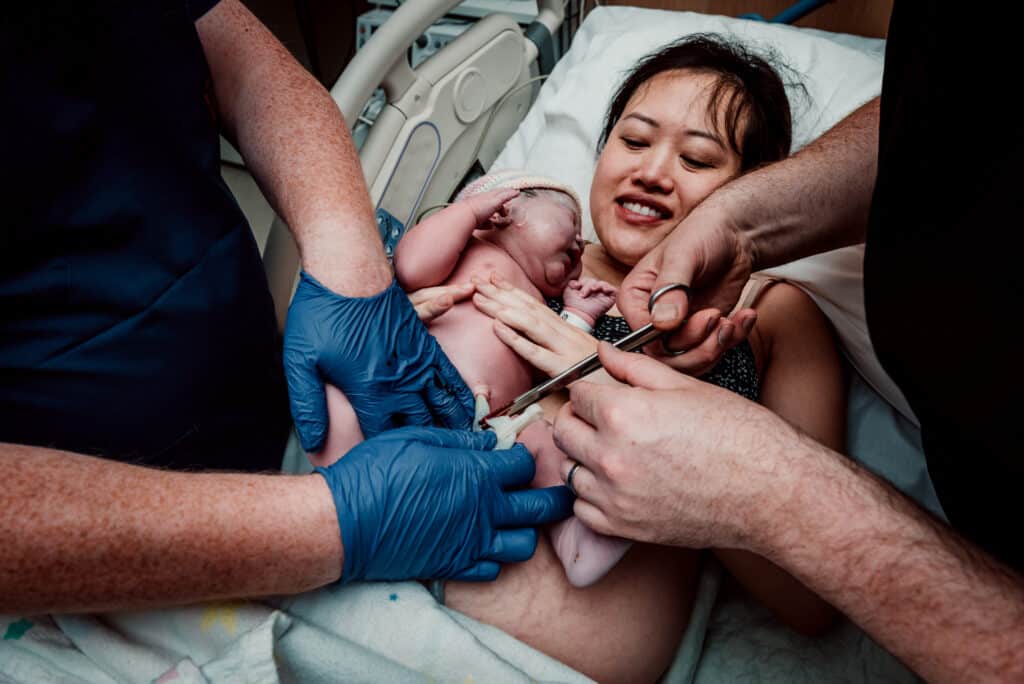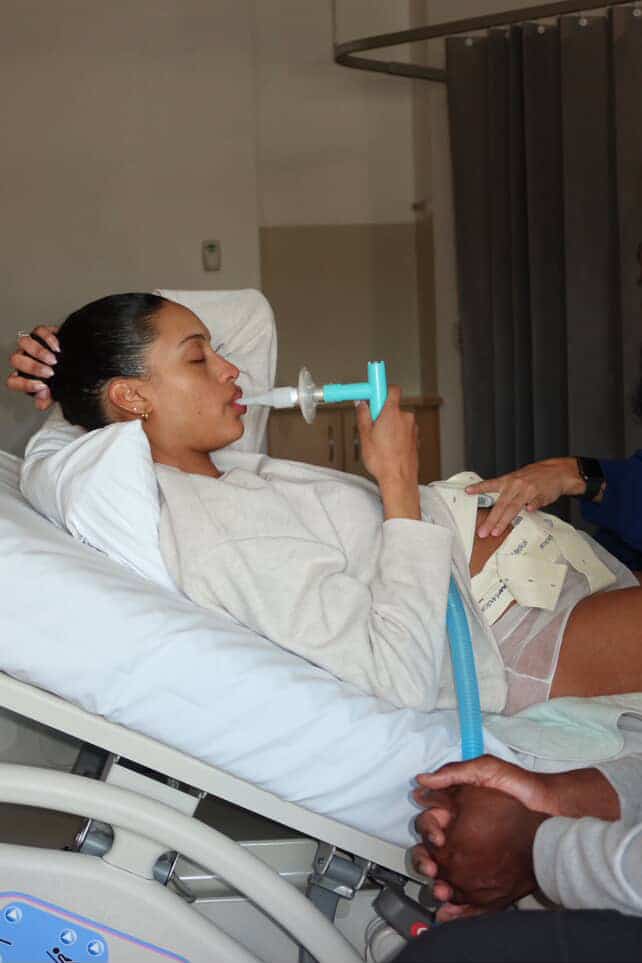Podcasts Marian
EPISODE 396
Marian

“I’m a planner so we did a lot of pre-planning; health checks, blood tests and ovulation tracking. I fell pregnant in mid-2021 and I was really excited. Looking back I was totally naive and we named her very early on and we’d started buying things…we were just so excited. I had pretty bad nausea and I was working from home because of covid lockdown and I just remember having a bin beside my desk in case I threw up.
The dating scan and NIPT came back clear so I felt really confident. I actually switched obstetricians halfway through my pregnancy as I was getting more educated from listening to the podcast and I started realising that getting the birth I wanted wasn’t going to be straightforward. My appointments were really short and transactional and I remember saying to him that I wanted to try for a vaginal birth and he said: you can try but the caesarean rate is 1 in 3. When I started having my doubts I was about 18 weeks but I was hesitant to change so I opted to get a doula and I connected with her – her name was Bree – and she said that she didn’t attend births with him as she’s had a bad experience in the past. That was a red flag for me. She described how he was in previous births and she encouraged me to switch if I wasn’t comfortable and she gave me a few obstetricians who she’d worked with previously. It was quite difficult to change obstetricians at that stage and it’s important to look at when they charge their management fee because if you do want to change care providers, it’s difficult to get that payment refunded.
My new obstetrician was amazing; he had a much smaller number of clients, I could tell that the midwives really respected him, he didn’t charge extra for appointments and he was incredibly caring and patient. We went to the 20 week scan and at the end the sonographer asked me to stay back as she had found that one of the ventricles in Emmy’s brain wasn’t normal. I just burst into tears in the waiting room. They suggested waiting a few weeks for further brain development so we went for a follow-up scan at 22 weeks. There wasn’t much change and the sonographer explained that there may be a margin of error so I walked away from that feeling like everything was going to be okay. However, the geneticist told my obstetrician that the scan didn’t look right. I had to go to another centre for another scan and the sonographer told me that the ventricles were bigger and she was missing the corpus callosum which is the bridge in the brain that connects the two sides together. I was distraught and they put me into a separate room where I called Eoin and he came and picked me up. I started googling what it meant and I was reading every paper I could find.
We were referred to the Foetal Diagnostic Unit (FDU) and Eoin couldn’t come to any of the appointments because of lockdown. I had an amniocentesis and the support team were so beautiful; they were all just so lovely. They did another scan while I was there and they confirmed that the baby had an absent corpus callosum (ACC) and the doctor was leaning towards a termination. I had read up on all these papers and told him that based on whatI understood, we were going to keep the baby, knowing that she would be intellectually delayed. The amnio came back clear but I was also sent for an MRI and they didn’t find anything else there. At that stage we were still feeling positive and we told our genetic counsellor that since we hadn’t found anything else, we felt confident to proceed with the pregnancy. She said that they would offer whole exome sequencing testing (WES) because with advances in technology it could be done in pregnancy and the results took three weeks. I was 26 weeks at that stage. Eoin and I had blood taken and they used the sample from the amniocentesis and they run a DNA sequence on the amnio sample to see if there’s any DNA issues. I had found a paper on women who had done this testing and the statistics said that there was a really high chance – over 90% – that it was going to be okay and there weren’t going to be any other DNA issues. We were clinging to any hope we could find.
I had also sought a second opinion from a geneticist and he looked at the scans and results and he felt that it was an isolated case of the ACC and that gave us comfort and reassurance too. They scheduled the results for the DNA testing over zoom and the head of the genetics department was quite concerned. They broke the news that Emmy had a rare genetic DNA mutation and they said the name of the syndrome and I immediately recognised it from my reading. I knew it was over at that moment; any hope or positivity was all gone. They basically said what it meant and it was things like a high likelihood of her being blind, deaf, feeding issues, severe intellectual disability, seizures, kidney, liver and heart issues. Eoin came home and we talked about it and we felt like we could handle intellectual delays but this diagnosis meant she would be in so much pain, not able to communicate with us and in and out of hospital. We knew we couldn’t go ahead and at that stage I was 29 weeks. It wasn’t fair on her and she wouldn’t have any quality of life at all.
We told the genetic counsellor and she told us that it had to go through an ethics team at the hospital which was fine but she also said that she would book me in straightaway. At that time we hadn’t thought about what it would mean to wait or go in immediately. Her view is that most people would want to do it straightaway. I had an appointment with a psychologist and she said in this situation that a lot of people want to cut themselves off from the baby, to do it straight away and numb the pain. But she encouraged us not to do that in terms of future healing. She encouraged us to cherish our time with her and make memories. We went to the park where we got married; we talked to her, read books to her, and we bought gifts for her. My sister took maternity photos for us, which was hard, but we wanted those keepsakes.
Our OB took us step by step through the procedure and I had a meeting with the maternity unit and they talked me through how much time I would get with her and the services available to make memories with her. My doula was amazing and she’d modified her birthing class to our situation so we went through the breathing techniques, teaching Eoin how to massage me.
The first stage of the process is that you go to the Foetal Diagnostic Unit and they ultrasound while they inject into the baby’s heart. The doctor was so supportive and told me that we had the full support of the ethics team. It was very peaceful and quiet and very gentle. My mindset was that I wanted to make it as calm for Emmy as possible. I wanted to honour her last moments instead of getting myself worked up. Eoin held my hand and we looked into each other’s eyes while it was happening. As horrible as it was, it was still a peaceful way to say goodbye to her.
After the procedure they gave me a pill and two days later I was booked into the birth suites. It’s all a blur and a total nightmare. I checked into the birth suite and they gave me a pill every four hours which is a slow build-up to induce. I could feel the contractions but it was nothing major. The lights were dimmed and I was playing music and staying quite calm and peaceful. I knew I wouldn’t get much time with her so I wanted to be fully there with her, and I wanted to feel everything, even the pain. It was the least I could do for her.
The contractions built up in the evening and I had a TENS machine on. It went from 0-10 so quickly. I got those rolling, strong contractions and then I felt like I needed to go to the toilet. Everyone knew what was going on so they encouraged me back to the bed. It was such a quick birth and then she was there. It was just…I think there must have been some adrenaline effect. Everything was so clear and quiet to me. I didn’t cry at all. They put her on my chest and there she was. She was so fragile.
Despite the regulations both my sisters were able to come and see Emmy and say goodbye to her. We had the night and morning with Emmy and I really felt that I wasn’t going to get anymore staying longer. Looking back I slightly regret that. We had all these kits to get her hand and footprints but she was so fragile, we couldn’t bring ourselves to do it. At Monash there is a midwife who specialises in making memories for stillborn babies or babies who have gone through TFMR and she took prints and photos and she made a book for us.
I started going to the online Red Nose Support groups; there’s a TFMR group. At the start we just sat there with the camera off and the microphone on mute just sobbing but they’re so helpful because they show you that you’re not alone. I was so naive about how many people experience this. I was pretty open about what had happened to me and at work people started sharing their own pregnancy losses with me; it’s common but so many people go through it.
I felt like I wanted to try again straight away and that’s what motivated me to get better. I knew I needed to recover physically and get in the right headspace. I read a lot of books on grief, I took three months off work so I had a list of things to do each day; I went for a long walk and listened to your podcast, I ate well, did yoga, and went to the support sessions. There was such a longing to hold a baby and to have a baby in my arms. I had all the hormones and emotions of a new mum, along with a postpartum body and milk coming in. It was so overwhelming to not have a baby to show for it.
My cycle returned after two months. At my six-week check my OB gave us the all-clear to try again. Our baby Leni was conceived four months after we lost Emmy. I was elated, I was so happy. It was our second cycle of trying and I was afraid that I would be very anxious but surprisingly I felt really good about things. Red Nose also does a Pregnancy After Loss group which was really helpful.
With Emmy it was determined that it was a random genetic mutation that most likely happened very early on. We did the genetic carrier testing and as soon as we found out we were pregnant we knew there would be extra testing. They offered a CVS to test for the same syndrome that Emmy had which we did and luckily we could rule it out really early on.
We still did all the things; we set up the nursery, we looked forward to everything and I didn’t want to be deprived of excitement and joy. In the back of my mind I still knew there were so many things that could go wrong. Nothing is certain and I did have anxiety about all the things that could go wrong.
Leni was measuring large and my OB said the risk is that she may have shoulder dystocia and she may not fit. Rationally I’d looked at the research but I also knew it was likely to be okay. I also knew the induction process carried risk. But because of my experience with Emmy, I knew I would rather induce if it increased the chances of Leni being okay, even if it meant increasing the chances of intervention for me. She ended up taking matters into her own hands because my waters broke at 38 weeks. I went in for monitoring and they booked me for an induction three days later. I went to an acupuncturist the next day and as she was doing it I started feeling contractions. She told me to go home, watch a movie and chill out. At 7pm I could feel the contractions starting to build but I didn’t say anything. By the end of the movie the contractions were so strong.
Eoin called the hospital because contractions were really close and they encouraged me to stay home but I knew I needed to go. By the time I got into the birth suite I was transitioning. Because Emmy’s birth was so quick, I assumed it would be the same with Leni but it wasn’t. It was very intense but manageable and that went on for an hour or two. My obstetrician came in and mentioned something about being on the clock. I was pretty determined to get her out so I tried lots of positions and the midwife told me to reach down and I could feel her head. Then she came out and they put her on my chest and it was amazing.
She cried and they allowed her to stay on my chest for two hours before anything else happened. It was an absolute relief and so redeeming. With Leni, no matter how hard anything is, I’m so appreciative and grateful. The newborn stage was a lot harder than I expected it to be. I wish I had understood how hard it can be and that I supported my friends in that stage more than I did.”


Topics Discussed
Amniocentesis, CVS, Doula, pregnancy after loss, Private obstetrician, TFMR, Two Babies, Vaginal birth
Episode Sponsor
Today’s show is brought to you by Kiwi Co.
I have to confess, I’m not much of a crafty mum, and if your daily routine involves taking care of a little one or two or three, in my case, why not switch things up with a Panda Crate Box from Kiwi Co.
Panda Crate is a subscription box filled with playful open-ended activities backed by research and designed especially for naturally curious and creative babies and toddlers with a Panda Crate subscription from Kiwi Co.
Your baby receives a new crate filled with two months worth of products and content every other month, whether you have a brand new baby or a trailblazing toddler, the Panda Crate is perfect for your little ones developing brain.
Build a foundation for early learning this new year with Panda Crate from Kiwi Co.
Get 50% off your first month with the code ‘Birth Stories’
Categories
Related Products
-
Birth Combs: Harness Your Body’s Natural Pain Relief
$24.95Crafted from smooth, natural wood, our birth combs activate specific pressure points in your hands that trigger your body’s innate pain-relieving responses.
Join the conversation
Sign up to get the latest updates, freebies, podcast releases straight into your inbox
@AustralianBirthStories
Follow along with us
@AustralianBirthStories
Follow along with us
@AustralianBirthStories
Follow along with us
@AustralianBirthStories
Follow along with us
@AustralianBirthStories
Follow along with us
@AustralianBirthStories
Follow along with us
@AustralianBirthStories
Follow along with us
@AustralianBirthStories
Follow along with us
@AustralianBirthStories
Follow along with us
@AustralianBirthStories
Follow along with us
@AustralianBirthStories
Follow along with us
@AustralianBirthStories
Follow along with us






